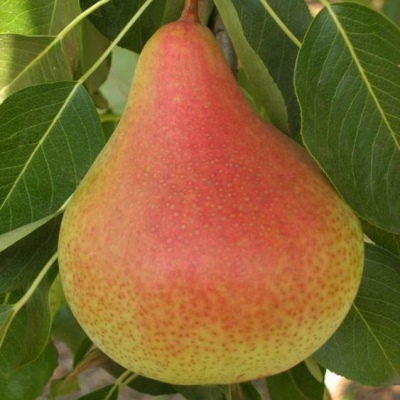
- Authors: RUE "Institute of Fruit Growing of the National Academy of Sciences of Belarus"
- Appeared when crossing: Alexandrovka x Favorite Klapp
- Fruit weight, g: 120-160
- Ripening terms: autumn
- Fruit picking time: from the second decade of September
- Appointment: universal
- Growth type: vigorous
- Yield: medium
- Height, m: up to 5
- Crown: wide pyramidal
Pear Fun is not for those gardeners who are used to having fun. This plant requires a responsible and attentive approach. And if the basic rules of care are followed, then it will not present any problems - that is why relevant information is so important.
Breeding history
Pear Zabava was created at the Institute of Fruit Growing of the National Academy of Sciences of Belarus. To develop the variety, Aleksandrovka and Lyubimitsa Klappa were crossed. The authors of the program are not personally mentioned in the official description of the plant.
Description of the variety
For Fun, strong growth is typical. Its trees are capable of reaching a height of 5 m. The crown looks like a wide pyramid. The foliage is not too great. Fruits will form on both simple and complex ringlets.
Fruit characteristics
Their mass ranges from 120 to 160 g. The obovate shape or the configuration of a wide rhombus is characteristic. Zabava's pears reach medium and even large sizes. A greenish-yellow color dominates in their color, but the integumentary color combines brown and red notes. It covers the main part of the fruit surface, but never completely fills it.
Rustiness, if present, is only insignificant. The flesh of the fruit turns a plain white color. The rind is moderately firm. Its smooth surface is always dry. The formation of gray subcutaneous dots is characteristic; you can save the harvest in room conditions for up to 21 days, in a chilled state - up to 80-90 days.
Taste qualities
Typical of this variety are:
sweet and sour range of tastes;
relatively powerful aroma;
the share of dry matter is 10.77%;
the entry of titratable acids 0.13%;
the concentration of sugars of all types is 8.16%;
tasting expert assessment 4.6 points.
Ripening and fruiting
Fun belongs to the category of autumn varieties. Harvest time usually comes around the tenths of September. It is believed that the consumption period covers two thirds of September and the whole of October. However, the weather can always interfere with this schedule. When using a semi-dwarf rootstock, you can achieve a harvest already at 3 or 4 years of tree development; regardless of this, it should bear fruit annually if everything is normal.

Yield
The declared ability to produce from 20 to 30 kg of fruit per 1 trunk. The harvest for plantation cultivation reaches 15-20 tons per hectare. Of course, all this strongly depends on the cultivation conditions.
Self-fertility and the need for pollinators
This tree is self-fertile. It needs such pollinating pears as:
Bere loshitskaya;
Autumn favorite;
Elegant Efimova.
Landing
You can plant a pear Zabava even on dense clay soil. In this case, you will have to prepare a large deep hole. It is unacceptable to use areas where groundwater approaches the surface closer than 2.5 m.If this cannot be avoided, it will be necessary to form a bulk ridge. It is required to choose thoroughly illuminated areas, protected by any obstacles from the north wind; Whether to plant a crop in spring or autumn - you have to decide on your own.


Growing and care
The official description insists on the high winter hardiness of Fun. But to abuse this ability of her is hardly reasonable. Such a plant is characterized by a moderately high resistance to fungal infections and bacterial cancer. At the same time, resistance to other infectious infections, including scab, is quite high. However, it is advisable to help the culture by maintaining the correct agronomic training and performing preventive treatments.
Watering should be active during the period of rapid growth. It is impossible to do without intensive irrigation even when the tree is in bloom, when the ovaries are folded. Regardless of the stage of the growing season, Fun should be watered intensively on hot, dry days. Timely mulching is very important. With proper planting, the plant will not require feeding in the first year.




Like any other fruit trees, the pear needs protection from various diseases and pests. When planting a pear on your site, you need to know in advance what diseases you should beware of. To successfully carry out the struggle, it is first necessary to correctly identify the cause of the problem. It is important to distinguish signs of disease from manifestations of the presence of insects, ticks, caterpillars and other types of pests.





































































